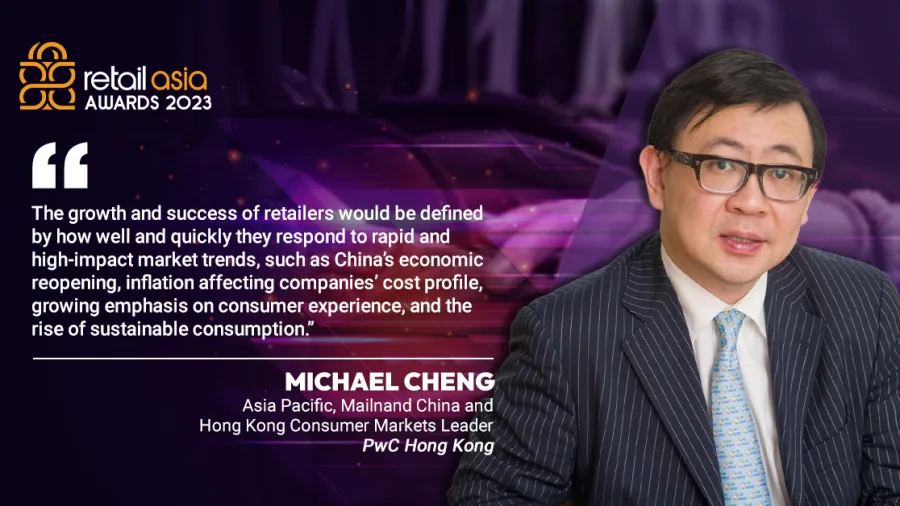
Addressing supply chain pain points will form a new source of competitiveness, says PwC leader
Michael Cheng observed that localisation, digitisation, and the circular economy would become major themes for supply chain innovation.
Michael Cheng has been PwC's Consumer Market Leader for the Asia Pacific, Mainland China and Hong Kong since 2013.
In his work, he is responsible for coordinating practice strategy and service delivery for companies in the Consumer Markets sector in Hong Kong, Mainland China and the Asia Pacific region. Overall, Cheng has over 36 years of professional assurance experience in Hong Kong and the United Kingdom. He also specialises in IPO advisory, business and due diligence reviews, asset injections and M&A activities in Hong Kong, Mainland China and Taiwan.
He also has an extensive experience in public speaking on the general trend and outlook of the Hong Kong retail market and has been invited to deliver keynote speeches at leading industry events.
In looking into the retail industry the past year, Cheng observed that the pandemic presented a new wave of disruption that challenged the status quo about the core drivers of demand: price, quality, and convenience. He said retailers and manufacturers began simplifying their supply chains, streamlining their product lines, and cutting down on physical store presence and non-core services.
“The future of consumption in the post-pandemic era will likely take on a hybrid form, combining the features of both online and offline settings to offer a seamless, unified omnichannel experience for shoppers,” he noted.
Cheng sat down with Retail Asia to discuss his thoughts on the trends in the consumer markets, how the retail industry evolved over the past year, and how retailers can measure their success for this year.
What do you think are some of the main challenges that the Asia retail industry has faced in the past year? What can they take away from these challenges?
2022 presented a new wave of disruption that challenged our status quo about the core drivers of demand: price, quality, and convenience. Many Asian retailers and manufacturers went into defensive and self-preservation mode during the height of the pandemic, as exports shrank and trade faltered. They began simplifying their supply chains, streamlining their product lines, and cutting down on physical store presence and non-core services.
According to our 26th CEO Survey, 53% of Asia Pacific CEOs, 14 percentage points more than the global average, believe their current business models will not survive within the next decade. The biggest challenge for them is to recognise the new dual imperative: to balance the execution of short-term profitability and long-term transformation. As such, companies must think and act on their feet – from innovating their customer acquisition model to exploring alternative revenue sources – in order to remain relevant. They will need to account for market changes in their medium- to a long-term strategy to future-proof their operations and anticipate new trends. Meanwhile, technology will continue to revolutionise online and physical retail, forcing rapid change and innovation as retail consumers will expect frictionless, tech-enabled experiences now more than ever.
On a positive note, Asia Pacific, including Mainland China and Hong Kong, is still home to a robust base of consumers who have shown resilience throughout the pandemic enabling strong economic recovery. We see strong fundamentals of the region to be further bolstered by trade liberalisation, particularly through the Regional Comprehensive Economic Partnership, and open markets that welcome foreign direct investment. Given China's prominent role in regional trade, its reopening and resumption of consumer activity would inject vitality and offer a timely boost to Asia’s retail industry.
What will be your key performance indicators in measuring retailers’ growth and success for this year? How can they meet these indicators?
The growth and success of retailers would be defined by how well and quickly they respond to rapid and high-impact market trends, such as China’s economic reopening, inflation affecting companies’ cost profile, growing emphasis on consumer experience, and the rise of sustainable consumption.
For example, the post-pandemic era calls for brands to have a robust online presence and relevant physical setups that revolve around experience. As the online and offline worlds converge, consumers expect, more than ever, to obtain products and services at any time and place. Hence, there is an increasing need to blend physical and digital experiences, as consumers are willing to pay higher premiums for emotional connections. The future of consumption in the post-pandemic era will likely take on a hybrid form, combining the features of both online and offline settings to offer a seamless, unified omnichannel experience for shoppers.
Another important criterion for measuring retailers’ performance is how well they are living up to the expectations of people, customers, and society, as ESG adoption continues to gain traction. Greater investor demand and stricter regulatory requirements on ESG issues meant that retailers need to proactively embed ESG goals and ideas into their corporate culture and daily operating activities. Retailers should also strategically invest in sustainability and ESG actions. Examples include driving inclusivity and social impact of new net-zero products and solutions, upskilling and reskilling to enable an inclusive workforce transition, integrating social metrics into reporting and disclosure around net-zero, and incorporating inclusion into policy advocacy efforts.
What trends should retailers watch out for when it comes to consumer markets? How can they stay on top of these trends?
There are a number of notable trends to look out for in 2023, with the most impactful ones being the structural shifts in supply chain setups, the rise of sustainable consumption, and technology encroachment into everyday life.
The COVID-19 pandemic has caused outsized disruptions to the global supply chain network, and in response, retailers are scrambling to reconfigure, if not reinvent their entire supply chain to stay relevant, agile, and competitive. Addressing supply chain pain points will form a new source of competitiveness for retailers. Localisation, end-to-end digitisation, and circular economy will become major themes for supply chain innovation. In particular, the source-local trend has appeared as manufacturers seek to consolidate their upstream supply chains and investors go value-hunting.
As consumer concerns about climate change intensify, sustainable consumption is likely to grow both as a disruptive force and a driver of value. Consumer awareness is on the rise for products that are ‘better for the environment and society’, especially amongst younger consumers, who are more likely to opt for products they believe will make a difference, albeit at a higher price. Retailers and wholesalers are attaching more importance to ESG involvement as socially conscious consumerism continues to grow.
Lastly, as China continues to scale its digital economy and with advances in VR, 5G, Web 3.0 and blockchain in what’s now known as the metaverse, convergence between physical stores and e-commerce over multiple devices and channels are enhancing omnichannel experience. Chinese consumers, especially the NextGen cohort, have their expectations from the metaverse. The pandemic drove a change in shopping behaviours and promoted ‘at home’ recreational activities, many of which will stay in the post-pandemic era. We see that brands are fortifying their products and service offerings to enable digital access. The metaverse has the potential to unearth new ‘virtual needs’ through the creation of rare digital items in the form of NFTs as related technologies continue to develop.
There are reports that point to the weak IPO activities for this year amidst the fall in last year’s volume and the threats of global inflation. What are your thoughts on this?
Global equities struggled in 2022 as markets had to cope with high inflation, tightening of global monetary policies, lockdowns in Mainland China, geopolitical issues and an energy crisis in Europe - all leading to global recession fears.
Despite a brief rally in the second half of the year, major global indices recorded double-digit losses for 2022, including the S&P 500 (down 19%), the Stoxx 600 (down 13%), and the Shanghai index (down 15%). The negative market sentiment dragged down 2022 global IPO proceeds by more than 70% compared to 2021. Nevertheless, China led globally in terms of IPO proceeds which made up 39% of the world's total in 2022, thanks to a wave of Chinese mega companies delisted from the U.S. and returned to China for listing.
As we entered 2023, fear of inflation, interest rate hikes and potential recession still loom in the market, we are likely to see a renewed appetite for IPOs featuring companies with a proven track record of growth and profitability, supported by a clear ESG story, strong balance sheet, stable cash flows and the potential to generate surplus cash for investment and return to shareholders. Companies that are likely to be positively placed for IPO success in 2023 will be those that can demonstrate profitability or at least a clear path to profitability. Privately held company valuations will need some adjustments to align with public market valuations to reflect the focus on company fundamentals. We expect the Mainland China capital market will continue to be an investment hotspot as the country officially reopens with the resumption of business activities and lifting of border restrictions, which will in turn boost domestic consumption and new investments in growth industries in 2023.
Being a returning judge in this year’s Retail Asia Awards, what are you expecting to see amongst this year’s entries?
I am very much honoured to be invited by Retail Asia for three consecutive years to serve as a judge of the Retail Asia Awards. I expect to see how participants innovatively create their products to take advantage of emerging consumer trends.
We learned that consumers are becoming more discretionary in their choice of channels, more accepting of domestic brands, as well as more conscious of the social and environmental impact of their consumption. I appreciate the passion and creativity that all the nominees have shown when competing for the Awards with their entries, especially for those who demonstrate agility and commitment in keeping up with macro market trends such as China’s speedy economic reopening and recent breakthrough in generative AI technology empowered by ChatGPT.
With the world getting back to normal, I hope to see brands and retailers willing to take bolder steps to rejuvenate and build their business models for sustainable growth under the ever-changing competitive landscape.



















 Advertise
Advertise








